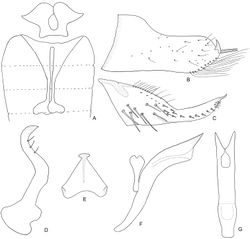Balera floripara
| Notice: | This page is derived from the original publication listed below, whose author(s) should always be credited. Further contributors may edit and improve the content of this page and, consequently, need to be credited as well (see page history). Any assessment of factual correctness requires a careful review of the original article as well as of subsequent contributions.
If you are uncertain whether your planned contribution is correct or not, we suggest that you use the associated discussion page instead of editing the page directly. This page should be cited as follows (rationale):
Citation formats to copy and paste
BibTeX: @article{Catalano2013ZooKeys352, RIS/ Endnote: TY - JOUR Wikipedia/ Citizendium: <ref name="Catalano2013ZooKeys352">{{Citation See also the citation download page at the journal. |
Ordo: Hemiptera
Familia: Cicadellidae
Genus: Balera
Name
Balera floripara Catalano & Paradell & Dietrich, 2013 sp. n. – Wikispecies link – ZooBank link – Pensoft Profile
Description
Length of male 3.7–3.8 mm. Ground color pale-yellow; crown, pronotum and scutellum with yellow markings; forewing with longitudinal yellow stripes on clavus and along CuA in corium, apical tip of clavus dark brown, with brown markings on bases of apical cells and apices of anteapical cells arranged in radial pattern (Fig. 1A). Male: First sternal apodemes (1S) (Fig. 2A) enlarged with apices overlapping. Second sternal apodemes (2S) (Fig. 2A) slender and elongate, reaching sixth segment, apices capitate. Pygofer (Fig. 2B) with posterior margin produced, with short, acute apical process directed dorsad and row of very long, thin setae on postero-ventral margin. Subgenital plate (Fig. 2C), in lateral view, with basal half strongly tapered, apical half with margin parallel through most of length, apex with a small spine slightly curved; basal half with several long macrosetae irregularly arranged and row of moderately long, slender microsetae on dorsal margin, apical half with medial row of short, stout setae. Style (Fig. 2D), in lateral view, sigmoid with three preapical setae. Connective (Fig. 2E) triangular. Aedeagus (Figs 2F–G) with preatrium nearly as long as shaft, dorsal apodeme compressed, racket-shaped in lateral view, incompletely fused to shaft; shaft short and broad, apex bifurcate, without processes; gonopore apical.
Material examined
Holotype male, ARGENTINA: Jujuy, P.N. Calilegua 1600m 23°41'1"S, 64°54'0"W, 14–16 January 2008 Dietrich et al col. Malaise trap [MLP]. Paratypes: 2 males, same data as holotype [INHS].
Etymology
The specific name refers to the arrangement of the five dark markings on the forewing arranged radially in the form of a flower.
Note
This species closely resembles Balera bracata but has a short process on the pygofer and the aedeagus is wider with the apical bifurcation shorter.
Original Description
- Catalano, M; Paradell, S; Dietrich, C; 2013: First report on the leafhopper genus Balera Young (Hemiptera, Cicadellidae, Typhlocybinae, Alebrini) from Argentina, and description of a new species ZooKeys, 352: 1-7. doi
Images
|

